近日,本团队在国际顶级期刊ACS Nano(JCR-1;IF: 15.8)上发表题为“Moisture Power Generation: From Material Selection to Devices Structure Optimization”的学术论文。本文通过从湿气发电(MPG)技术的背景和基本原理出发,深入阐明了如何选择合适的材料(碳基材料、半导体、高分子化合物、生物质材料、无机盐材料等)和优化器件结构(孔隙结构、水分梯度结构、官能团梯度结构、电极结构)来解决现有和未来的挑战。此外,本文还强调了影响推进MPG技术的主要障碍,并为高性能MPG器件的开发提供了潜在的见解。
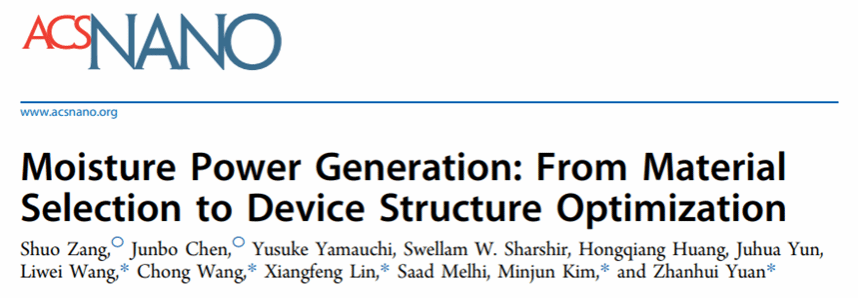
全文速览:
湿气发电(MPG)是一种在湿度环境中利用材料吸收空气中的水分,并将吸湿后材料内部产生的化学势能转化为电能的技术,其在一定程度上摆脱了环境对发电的影响。近几年来,为缓解能源危机,从环境中获取绿色可持续的新能源,MPG技术得到不断发展与改善,但仍面临诸多困难。目前,MPG单元发电性能不足是MPG所面临的最严峻的挑战。
因此,本文详细介绍了MPG的原理,回顾了以往的MPG的研究成果,从材料探索方向与结构选择方向出发,归纳了如何选取合适的MPG设备的材料与结构以解决上述问题,并进一步为MPG的发展提出建议。此外,本文还讨论了MPG未来发展的部分挑战和机遇。
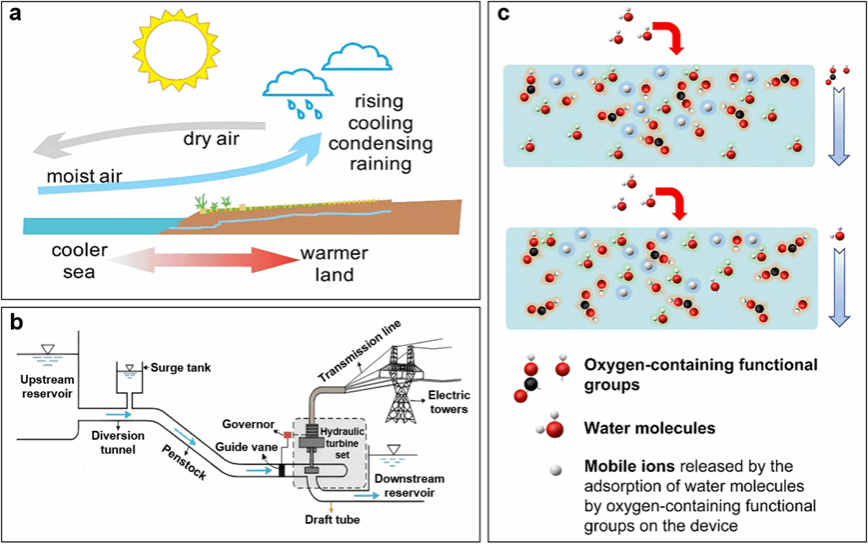
Figure 1. (a) The water cycle between the ocean and the land20. (b) Hydroelectric power plant structure. (c) Schematic mechanism for electrical generation based on streaming current and ion gradient diffusion.

Figure 2. Principle of MPG. The ionic gradient structure pushes the free ions in the bilayer to move directionally, which in turn creates an ionic current.
如图一、图二所示,在传统的水力发电中,发电机利用河流的水位落差这种“物理特性”来发电。与传统的水力发电不同,MPG技术利用材料吸湿后自由离子的解离与定向迁移进行产电。因此,流动电流与离子梯度扩散是构建MPG设备主要的两种发电机理。在实际情况下,这两种发电机理能够同时在设备中发挥作用,协同提高设备的产电能力。

Figure 3. (a) Linking of electrode circuits for most MPG devices. (b) Exchange of moisture between MPG devices and the environment.
如图3所示,大部分MPG器件的电极主要通过粘合和挤压连接到发电单元,通过与环境间不同的水分交换实现发电。通过电化学工作站或万用表等仪器可以获得一组代表MPG器件发电能力的数据。

Figure 4. The evolution of MPG can be divided into four distinct structures: the electrode structure, the water gradient structure, the pore structure, and the gradient structure of the functional group. Throughout its development, MPG has been used to a variety of fields, including body portable power supplies, humidity sensor and drive electronics, and synergies with other technologies.
如图4所示,MPG的发展可以从四种不同的结构来进行阐明——水分梯度结构、孔隙结构、官能团梯度结构和电极结构。在整个发展过程中,MPG已被应用于多个领域,包括车身便携式电源、湿度传感器和驱动电子设备,以及与其他技术的协同发展。
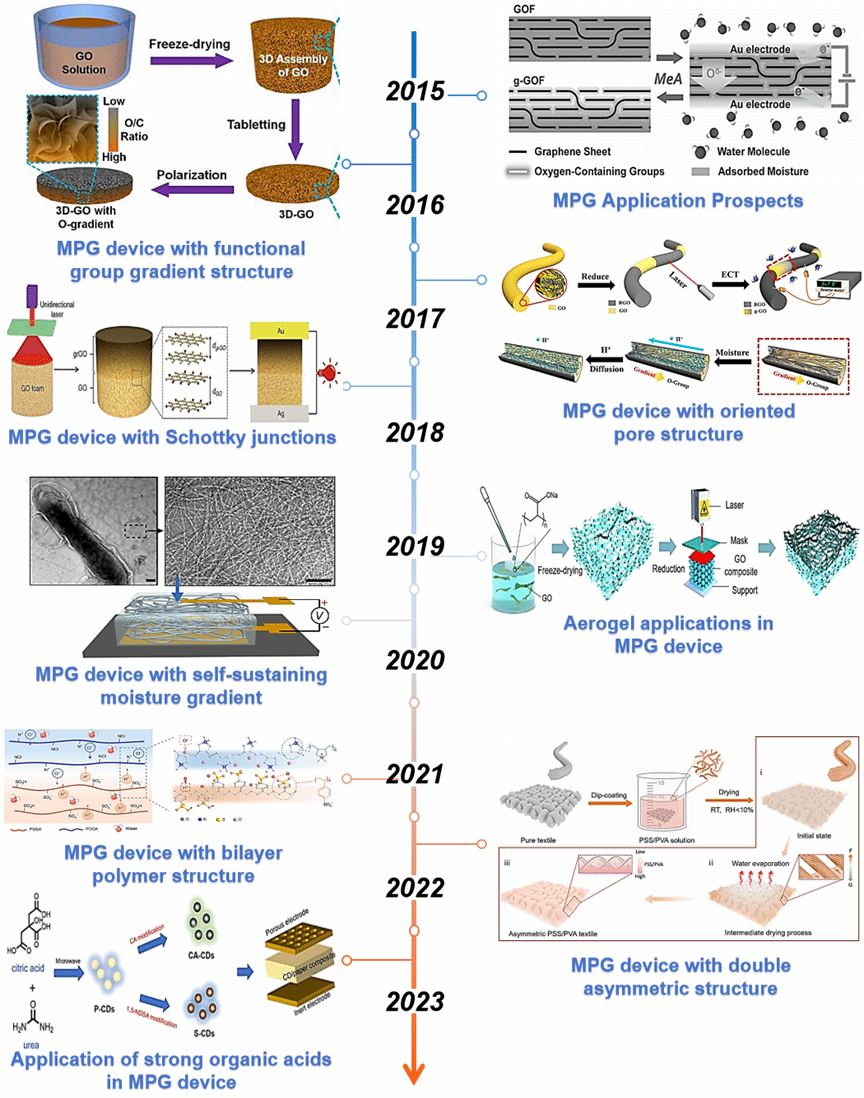
Figure 5. Timeline showing the key developments in MPG.
如图5所示,MPG作为一种从环境中获取能源的新兴技术,其自2015年被提出以来,近几年得到了快速的发展。
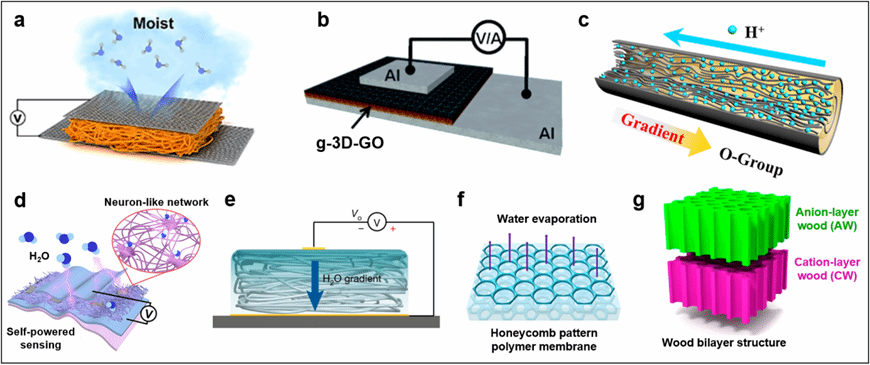
Figure 6. Improvement of MPG performance by optimizing pore structure. (a) cellulose acetate membranes MPG device. (b) GOMPG device prepared by electrochemical polarization method. (c) GO Fiber MPG device with highly oriented pore structure. (d) Nb2CTx/SA composite membrane MPG device with a neural network-like structure prepared. (e) Nano protein fiber MPG device using vapor pressure gradient. (f) CA film MPG device with asymmetric structure on both sides. (g) Bilayer wood film MPG device with natural pore structure.
如图6所示,孔隙结构是MPG发展的关键组成部分,通过优化孔隙结构,可以提高器件的离子转移速率,同时纳米级别的孔隙结构能够创造一个提高MPG性能的水分梯度。其中,孔隙大小是影响MPG中孔隙结构的重要指标,较小的孔隙可能由于毛细管作用导致传输离子更快,从而发挥更好的作用。此外,在孔隙结构方面仍有很多的研究机会,特别是对于水凝胶MPG器件。如优化水凝胶MPG器件的孔隙结构,特别是建立定向孔隙结构,减少离子输运过程中的阻碍,加速离子输运;建立两侧具有不同孔隙结构的水凝胶MPG器件,可以分别有效地增加与空气的接触面积和离子的快速输运。

Figure 7. Study on the construction of moisture gradient by unilateral sealing method. (a) GOMPG device for building a moisture gradient using a coin cell housing. (b) GQDs MPG device. (c) TiO2MPG device constructed by electrophoretic deposition method. (d) PSSAMPG device. (e) Aerogel MPG device prepared using bio-nanofibers. (f) MPG device utilizing whole-cell sulfur-reducing Geobacillus. (g) Inorganic salt MPG device. (h) MPG device for organic-inorganic hybrid halide perovskite materials.
在MPG中,水分梯度可以通过单侧密封、调节孔隙结构和使用水凝胶来构建,其中单侧密封是构建水分梯度最常用的方法。如图7所示,在单侧密封类型的MPG器件中,选择良好的吸湿材料能够有效的提高MPG性能。此外,其与官能团梯度结构能够协同提高器件的整体性能。

Figure 8. (a) TCGP hydrogel device. (b) TiO2 device that utilizes hydrogel to provide moisture. (c) Functionalized carbon layer MPG device that utilizes hydrogel to provide moisture. (d) Construction of moisture gradient using pore structure in CNF/GO MPG device.
如图8所示,调节孔隙结构和使用水凝胶能够辅助MPG器件构建稳定的水分梯度。其中纳米级孔隙结构由于蒸汽压梯度的原因能够构建自维持的水分梯度,此外,发电单元两侧不同的孔隙结构导致材料两侧的水分梯度,而水凝胶与环境间稳定的水分交换可以为MPG器件提供稳定的水分梯度。

Figure 9. (a) GOMPG device for building functional group gradients using moisture-electric annealing. (b) Construction of PDDA/PSS MPG devices with functional group gradients using bilayer membranes. (c) MPG device for constructing functional group gradients using photosensitive pigments. (d) Construction of PVA/GO MPG device with functional group gradient using acid treatment method. (e) Construction of PSS/PVA MPG devices with functional group gradients using natural sedimentation method.
如图9所示,与水分梯度相比,官能团梯度更稳定,更容易构建器件内的离子梯度,从而鼓励研究人员探索增加MPG器件中官能团梯度的有效策略。目前,湿热退火法、化学氧化法、自然沉降法、双层膜建设梯度法是构建官能团梯度的主要方法。此外在MPG中,官能团梯度可以配合水分梯度促进MPG的发电性能。
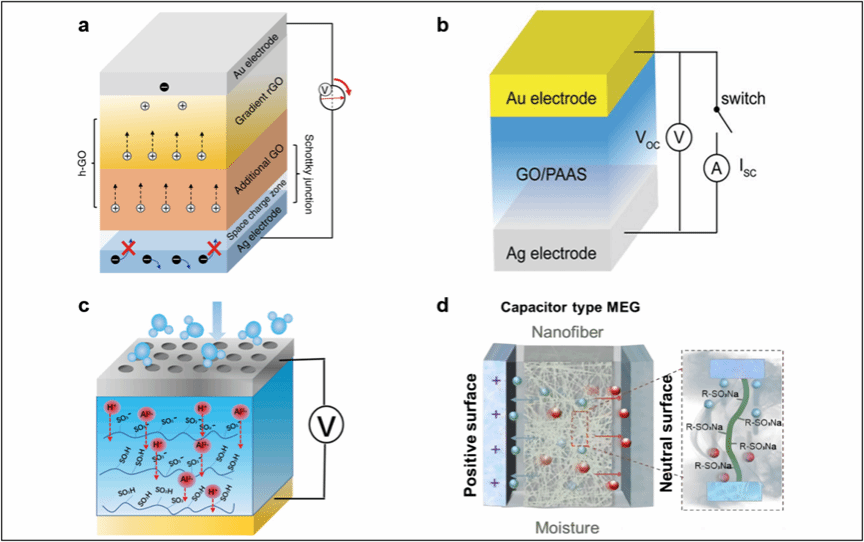
Figure 10. (a) GOMPG device with Schottky structure. (b) PAAS/GO MPG device with Schottky structure. (c) PAN/PSSA MPG device with active electrode structure. (d) MPG device constructed with electrode pairs having different charges.
如图10所示,MPG的电极选择主要从三个方向进行研究:1)构建肖特基触点,2)构建电容器,3)选用活性电极,提供自由离子。具体而言,肖特基接触MPG器件通过在电极和发电器件之间形成能量屏障,从而使电流向一个方向传输,从而产生定向离子流或电流。相反,MPG器件中的电容器在电极表面极化时引导离子流动,并吸引相反的电荷离子。离子向极化电极表面的运动依次产生各自方向的离子流动。电极构建的特殊结构作为一种极具发展前景的“轨道”,在MPG中仍有很大的研究空间。
最后,本文从材料工程和实际应用的角度,结合最近的应用,对MPG的未来发展提出了一些建议。
1、提供额外的能量来源。在未来的研究中,可以利用不同地区的环境条件来辅助发电,开发环境集成的MPG器件。
2、具有自维持水分梯度结构的MPG。通过减小孔径和膜的厚度,可以在孔径内外形成蒸汽压差,从而实现自我维持的水分梯度结构,便于MPG器件内的水分输送。
3、与光催化产氢相结合,由于MPG器件可以吸附空气中的水分,因此可以与光催化制氢技术相结合,构建一种可以同时发电和制氢的器件。
4、与应用于蒸发发电领域的光热蒸发技术相结合,基于大多数MPG器件具有丰富的孔隙结构和优异的水传递性能。光照射不仅可以促进材料内部水/离子的定向传输,还可以通过提高水/离子传输速率来提高发电性能。然后,可以制备一种既具有光热蒸发又具有发电功能的器件。
论文信息:
Moisture Power Generation: From Material Selection to Device Structure Optimization .
Shuo Zang, Junbo Chen, Yusuke Yamauchi, Swellam W. Sharshir, Hongqiang Huang, Juhua Yun, Liwei Wang, Chong Wang, Xiangfeng Lin, Saad Melhi, Minjun Kim, Zhanhui Yuan.
ACS nano, July 25, 2024
DOI:https://doi.org/10.1021/acsnano.4c01416

